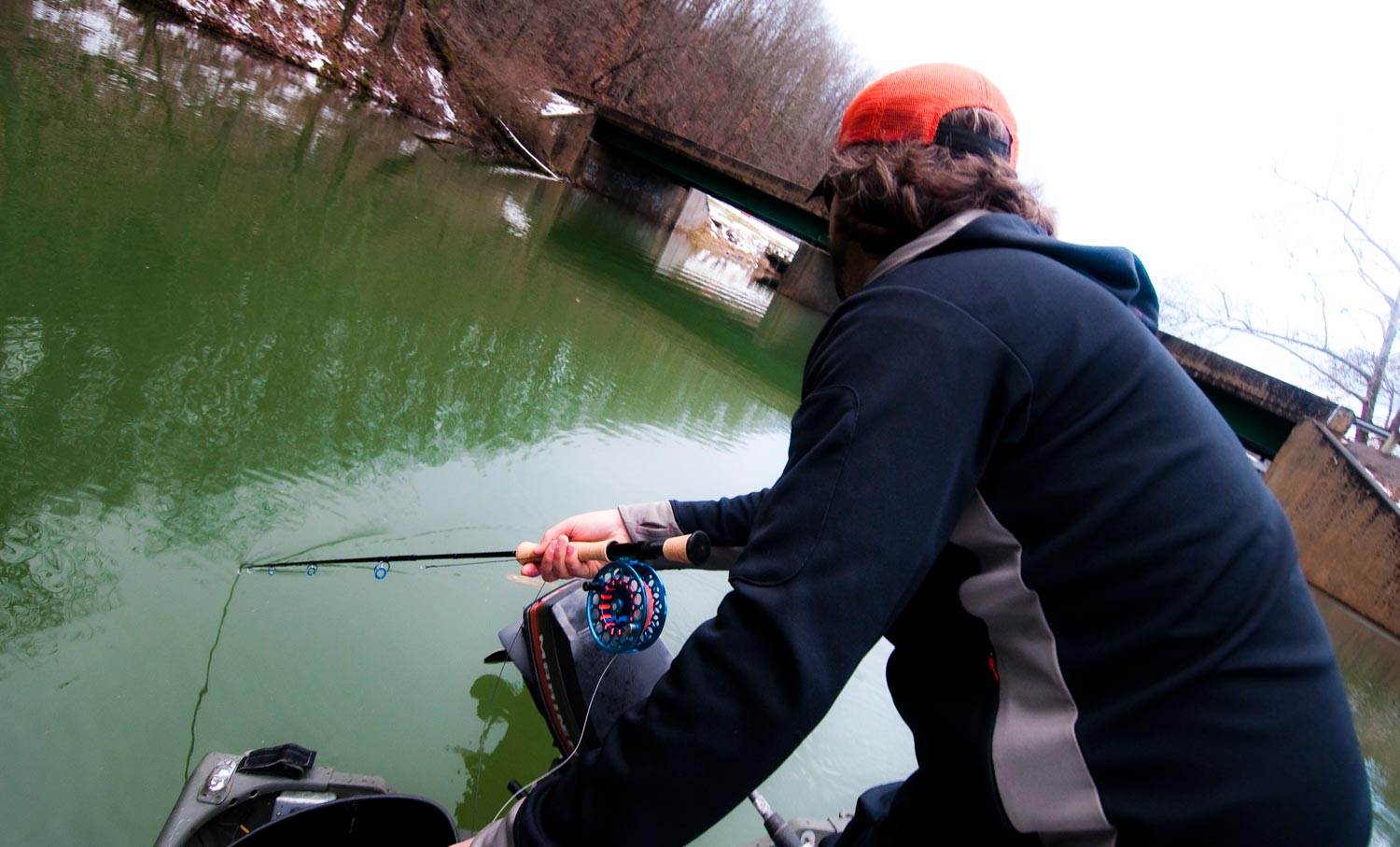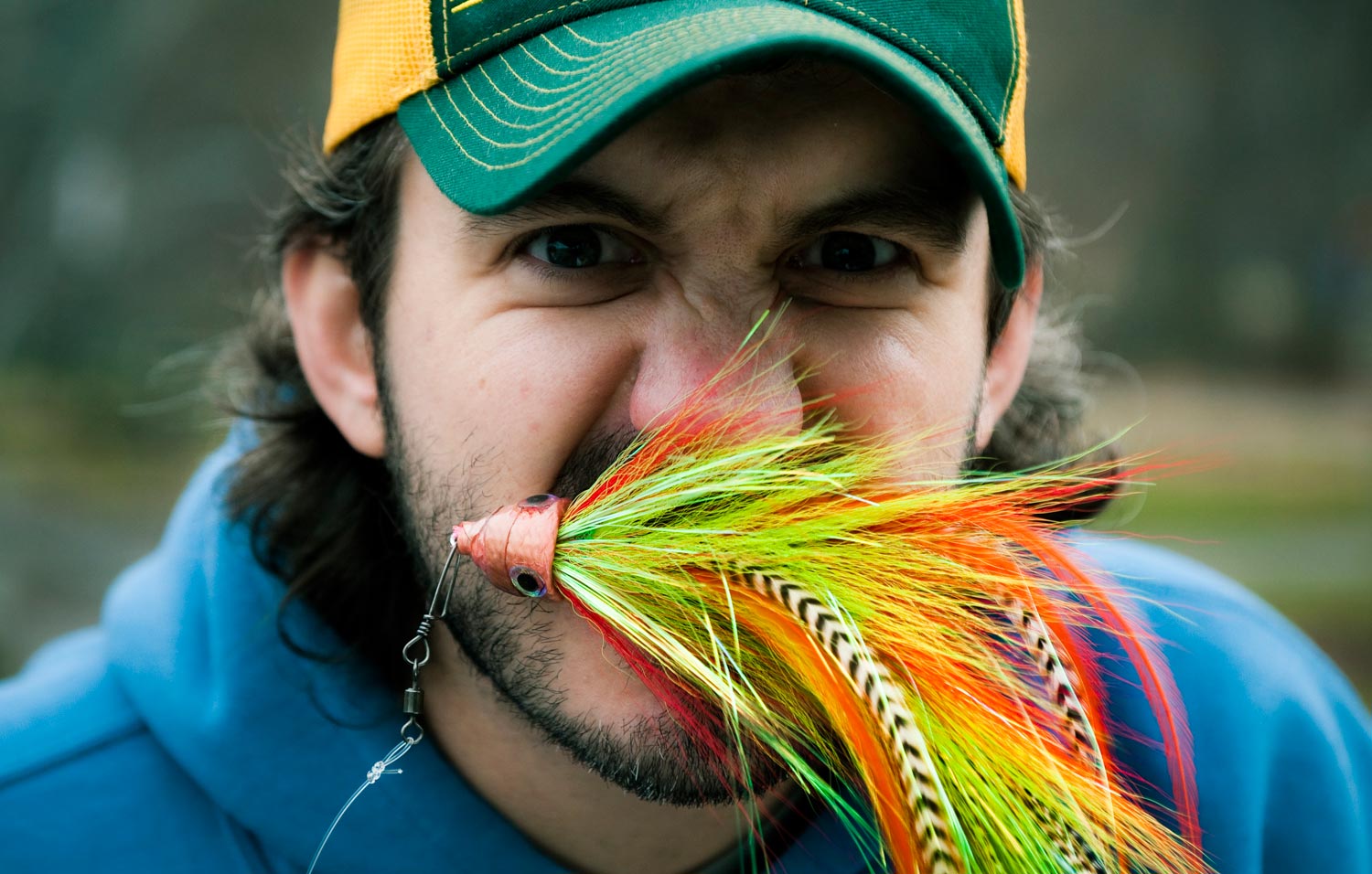For the first time, this year, I got to experience the thrill of watching a musky devour my bucktail streamer right at the boat during a figure-eight retrieve.
I had dreamed of witnessing this first hand for years, and I have to say, it live up to all the hype. You get a huge adrenaline rush every time you lure a musky into following or eating your fly during a figure-eight retrieve. I think this one aspect of musky fishing alone, is why so many anglers fall in love with musky. Although I’ve heard of anglers catching trout, striper and other species with a figure-eight retrieve, musky by far, provide the highest success rate of all game fish for using it. Musky seem to spook far less than other game fish when they’re in hot pursuit after prey, and that’s the main reason this niche retrieve works so well for them. I totally screwed the pooch on my first couple opportunities to use the figure-eight retrieve for musky. This unorthodox retrieve takes a while to get used when you don’t regularly practice it. Done wrong, a figure-eight retrieve will fail to trigger eats. Luckily, during my trip, I had my good friend Charlie Murphy, a genuine musky bum, give me some pointers. Below are six tips to get you executing a figure-eight retrieve like a pro.
Tip 1: You have to consistently use the figure-eight retrieve for it to work.
Charlie told me, point blank, “if you don’t follow up every cast with a figure-eight retrieve, you’re giving away opportunities to catch musky.” Many times, musky will be following your fly just out of sight, and your only chance for catching these fish, is to trigger a bite with a figure-eight retrieve. I watched Charlie musky fish for four straight days, and there wasn’t one time, where he didn’t finish up his retrieve with a figure-eight. It took me a while to follow his lead, but when it was all said and done, Charlie proved his point by getting the most follows and eats during the trip. The best thing you can do if you’re serious about catching musky, is get in the routine of consistently using a figure-eight at the end of every retrieve.
Tip 2: A proper figure-eight retrieve starts with your fly at the correct distance from your rod tip.
I found out real quick, if your fly is too far away from your rod tip during a figure-eight retrieve, it’s impossible to execute it properly. Charlie explained to me, that ideally, all you want is a foot or less of leader out the end of your rod tip. Anymore, and you’ll find slack becomes a real issue. Slack will cause your fly to slow down or even stop momentarily during a figure-eight retrieve, resulting in your fly looking unnatural and causing musky to lose interest. It’s critical that you’re always making your fly look like prey fleeing for its life. By keeping your fly at the correct distance from your rod tip during a figure-eight retrieve, you’ll find it much easier to keep your fly moving, and it will provide you with the greatest control and range of motion.
Tip 3: Speed and depth change are very important with a figure-eight retrieve.
Most anglers would agree that when you’ve got a fish following your streamer and it’s not committing, you generally want to speed up your retrieve to trigger a bite. Most of the time, when prey are getting chased by a predator, they will change direction and sprint for short bursts to avoid capture. When a predator sees this, its instincts generally take over, and the predator will counter by increasing its speed also. Fly anglers need to keep this in mind when they find themselves with a musky following their fly during a figure-eight retrieve. If the musky is following but not committing your goal is to get the fish to pick up speed and commit. Usually the best way to do this, is to speed up your fly. Charlie recommends that you should begin speeding up your fly right as your coming through and out of the first turn of your figure eight. The theory is, it mimics prey making and abrupt direction change and then fleeing away. During the trip, I noticed that almost all the muskies ate our fly during the turn of a figure-eight or shortly after, and increasing the speed of the fly was the key variable in triggering a bite.
Depth change is also very important during your figure-eight retrieve. Anglers need to pay close attention to the depth of the following musky, and try to match it with their fly. Charlie says that it’s also important to change the depth during the retrieve, and that you should also focus on the depth change being made from the turn of the figure-eight through the straightaway. Charlie says, “I strive for a one to two foot depth change in-between each turn of my figure-eight retrieve.”
Tip 4: Don’t give up on your figure-eight retrieve prematurely.
I’ll never forget how astonished I was to see Charlie make five or six figure-eights with his fly in a row, and finally get a following musky to eat. Whatever you do, don’t prematurely give up on a musky if you lose sight of it, because they often will drop out of sight for a minute, and then come right back and eat your fly. I’m not sure why musky do this, but I personally think they’re trying fool their prey into thinking they’ve escaped, so they can come back moments later and ambush them off guard. Think about, if you were that unlucky fish swimming your ass off trying to keep from being eaten by a musky, and then you looked back and the musky was gone, it seems pretty easy to believe that you’d think you had escaped and the threat was gone.
Tip 5: Always move your fly away from the musky.
It seems pretty obvious that you should aways move your fly away from a musky during a figure-eight retrieve, but you’d be surprised how the intensity during a figure-eight retrieve will have you thinking otherwise. Prey never swim towards the mouth of predator, so make sure that you’re thinking about the next turn in your figure-eight so you choose the right direction. Choose wrong, and it may result in you missing a fish. Charlie also recommended that anglers should try to keep their fly moving away from the boat when possible. He likes to begin his figure-eight retrieve by taking the fly past the bow of the boat first, instead of towards and alongside the boat. The later can result in spooking a fish.
Tip 6: Set the hook in the opposite direction you’re moving the fly.
Most musky eats are lost during the hookset of a figure-eight retrieve. No upright trout hooksets here folks, nor should you set the hook away from the fish. This usually end with you pulling the fly out of a musky’s mouth. Always try to set the hook in the opposite direction of your tracking fly. Another way to look at it is, always set the hook towards the musky. This usually will result in you hooking the fish in the corner of the mouth.
There you go, there’s six tips for executing a proper figure-eight retrieve. I pretty much learned how valuable each one of these tips were during my musky trip with Charlie. Thank you Charlie for guiding me to my first musky on the fly and teaching me the tactics needed to be successful.
For more tips from Charlie Murphy about fly fishing for musky click here.
Keep it Reel,
Kent Klewein Gink & Gasoline www.ginkandgasoline.com hookups@ginkandgasoline.com Sign Up For Our Weekly Newsletter!


“…all you want is a foot or less of leader out the end of your rod tip.”
So you’re starting each and every cast from scratch? Seems to be a pain in the *ss. Although I hear most eats with musky are in the figure eight, so I’m sure it’s worth it. Any tips on how to start recasting with all your leader in the rod?
Speaking of leaders, what sort of set up do you use for musky on the fly rod, leader and tippet -wise?
Dan,
Musky flies are so large and heavy especially when using a full sink line that it only take one little lobbing backcast to get the needed line back out in the water. Or you can just let some line out to get back into your fly line while your fly is still in the water and your done with your figure 8. I also like to use a stripping basket if possible. Flies measured in feet, 10-12 wt rods, full skin lines is all part of the musky challenge.
1 foot of 30 pound and 1.5 of 50-80 pound test.
After making your figure -8’s, shake some line out the rod tip and then make a roll cast to straighten it all out. Then you can water load to get the next cast started.
Good stuff guys. I wanted to mention that there is an entire chapter on this very subject in Robert Tomes book Muskie on The Fly…including excellent illustrations. That’s a must read book on the the subject of fly fishing for muskie!
Word on the street is this guy sent you some flies and smokes. Did you enjoy either one of them?????
James,
We enjoyed both very much. What’s your website so we can tell people about your killer Pike Flies you sell?
Kent
James,
My local toothies really seemed to enjoy that pattern you sent along with the boys. Really great sucker imitation.
http://www.cowboyflyfishing.blogspot.com/
Big Pike Flies as a Way of Life
“Seems to be a pain in the *ss.”
Musky fishing is a pain in the ass, and the shoulder, the elbow, the hand and its pretty rough on the psyche as well
Guy, I 100% agree with you. my wrist takes a pounding from generating all that momentum with a big rod and fly in hand. i’m gonna make myself practice casting left handed. Lower back gets tight and sore from staying slightly leaned over ready for the strike and bending into he figure 8. Musky are a bitch of a fish…..pure awesomeness!!